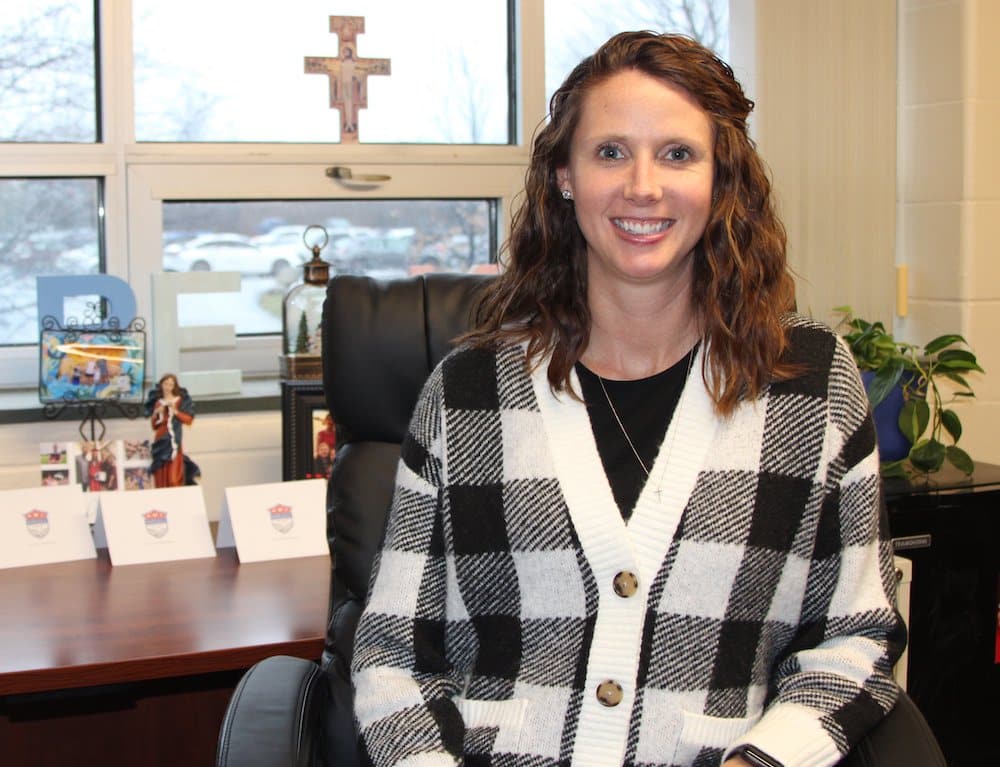INDIANAPOLIS (OSV News) — When does “just being a teenager” cross the line to a true mental health issue? What are the main causes of adolescent depression and anxiety? Why is it increasing? And how can faith help the healing process?
Between 2009 and 2019, the rate of adolescent depression nearly doubled, increasing from 8.1% to 15.8%, according to a 2021 analysis of National Survey on Drug User and Health studies during that decade. The most recent NSDUH study for 2022 shows that figure has risen to 20.1%.
“Hormones are a factor” in teen mental health, said Diana Buxton, a licensed clinical social worker at Roncalli High School in Indianapolis. “The teen brain is still developing. And teens generally just don’t talk to their parents.”
In interviews with The Criterion, newspaper of the Archdiocese of Indianapolis, two Catholic high school social workers and a Catholic licensed mental health counselor shared their insights about teens and mental health.
Some sources of teen anxiety and depression are fairly common. The list of causes the three interviewees identified were almost identical: pressure to make good grades, to excel in sports, to be accepted by peers; anxiety about the future; and family issues.
But all three also noted the tremendous impact of the pandemic and social media — particularly via cellphones — that today’s adults never dealt with as adolescents.
“The pandemic has had a huge impact on teen mental health,” said Aly Weaver, a social worker at Cathedral High School in Indianapolis. “Most students were (essentially) by themselves for two years trying to learn online. As a result, many teens suffer from social anxiety, generalized anxiety and/or depression.”
Weaver notes that teens might struggle with how to communicate their feelings, but that emotions like “hopelessness or persistently feeling sad for no reason have come up frequently in sessions with kids.”
Effects of the pandemic
Her local observations match up with national findings.
A 2022 Centers for Disease Control and Prevention study of the pandemic’s effect on teen mental health found that in 2021, 37% of high school students reported they “experienced poor mental health” during the pandemic, and 44% reported “persistently feeling sad or hopeless during the past year.”
“The pandemic brought out more stressful moments,” said licensed mental health counselor Justin Griswold of Pax Counseling LLC in Indianapolis. “For some, the extreme isolation and loneliness they felt was traumatic.
“It’s been a hard transition from online to face-to-face for a lot of people, including teens,” he added. “And I think that results in a struggle to make and maintain good friendships, especially in teens.”
But the pandemic is not the main source of teen depression today, according to an April 11, 2022, article by Derek Thompson published in The Atlantic.
In the article, he quotes Laurence Steinberg, a psychologist at Temple University in Philadelphia: “Rising teenage sadness isn’t a new trend, but rather the acceleration and broadening of a trend that clearly started before the pandemic.”
That trend is social media, particularly through the use of smartphones.
“Around 2012, I noticed abrupt shifts in teen behaviors and emotional states,” psychologist Jean Twenge said in her Sept. 15, 2017, article in The Atlantic called “Have Smartphones Destroyed a Generation?”
After further research, she made a discovery: 2012 was the year when the number of Americans who owned a smartphone exceeded 50%. By 2015, the number had risen to 92%.
Other studies also show a correlation between social media use — primarily via smartphones — and teen depression.
For instance, a 2020 internal study by Facebook Inc., (now Meta) found that one-third of teen girls said Instagram “made them feel worse,” yet they felt “unable to stop themselves” from logging on.
Being “unable to stop” is true regardless of gender. Teens ages 13-18 spend an average of nine hours on their phones per day — not including use for homework — according to a 2021 study by Common Sense Media.
Part of the inability to put the phone down is that age group’s use of social media as an indication of acceptance, said Griswold.
“One of the main tasks as teens is to stand out, to figure out ‘who am I compared to everyone else,’ trying to fit in and be accepted by a group of people,” he explained.
Addictive devices
But there is another, more scientific factor affecting teens’ excessive use of smartphones, Griswold added.
“Phones are more like slot machines than a place for information,” he said. “They trigger a dopamine response that makes you want more, and teens are extra sensitive to dopamine.”
The negative impact on teens of all this screen time — particularly using social media — is pervasive. Griswold lists dangers like “exposure to hurtful people, cyberbullying, porn, the stress of always being on, always in contact, the fear of missing out — FOMO.”
And by staying up too late “connecting with friends,” teens are “not getting homework done, not getting enough sleep so they’re tired and can’t regulate their emotions as well,” he added.
Buxton said social media use “is a major factor in mental health issues in the students I see.
“The comparison to others causes a lot of self-esteem issues,” she said, and information overload “causes a lot more feelings of confusion, pressure and stress.”
“There are other factors too, of course, and the ‘nature versus environment’ debate is still active in regards to mental health,” she added.
Regardless of the cause for teen anxiety, stress and depression, counseling can help.
“Imagine a ball of yarn tangled with many different colors. These are your thoughts and feelings all tangled together,” Weaver said in explaining the benefits of teen counseling. “Sometimes it can be really hard to tease through each piece by yourself. Without tools, these strings can stay tangled or stuck in place. A therapist is there to help you look at each piece of yarn separately and untangle them to make more sense.”

Symptoms teenagers face
As stress and anxiety levels rise, symptoms such as “isolation, trouble sleeping, being tired, grades decreasing, physical pains can all be indicators of a mental health issue,” said Buxton.
In the case of physical symptoms, she advises first taking the teen to a doctor to rule out any physical problem.
For behavioral symptoms, Griswold offers adults three tests to determine if a teen needs help: intensity, duration and the teen’s normal character.
For intensity, he said, consider if the teen’s emotions “are larger than what would normally fit into a response, like if you take away their phone and they react violently and start throwing things.”
Similarly, note how the behavior “fits with the typical character of the child,” said Griswold. “If the child was irritable growing up or short-tempered, is [their current behavior] just part of their character? If it’s a large, drastic change from who they are, they might need help.”
Finally, he said, consider how long the behavior has lasted.
“Depending on the emotion, if it lasts more than one to six months” it could be time to “consider if this is a growing pain or if it’s time to seek help,” said Griswold.
Advice for parents
He recommends parents ask their struggling teen open-ended questions such as, “What changes have you noticed in yourself?” and ask if they’d like help.
“You can say, ‘Let’s try one or two (counseling) sessions and see what you think,'” he suggested.
For nonparents who notice a teen struggling, Griswold recommends they talk to the parents “about the changes they’ve noticed and the impact it’s having. Come from a place of concern to soften that topic, like, ‘I’m seeing a big struggle your child is going through.'”
One point all three specialists emphasize is the importance of taking action at any sign or mention of suicide or self-harm.
“If you see harm, it doesn’t matter if they want help or not — they need help,” said Griswold.
Buxton added that if an adolescent tries to take his or her life or mentions thoughts of doing so, “that always needs to be taken seriously. They might say, ‘I was just joking’ or ‘I didn’t mean it,’ but it still needs to be taken seriously because there might be something else going on. “When it’s not talked about is when problems persist and become more complicated.”
If the teen is open, incorporating faith into counseling “can bring a sense of purpose,” said Griswold, who holds a master’s degree in counseling from Franciscan University of Steubenville, Ohio, with an emphasis on Catholic/Christian counseling.
“It can help them understand their value and worth, and a lot of them are asking about their value and worth. Faith gives an answer to that.”
And drawing upon the Catholic faith in particular can help counselors assist their clients — teen or otherwise, he added.
“Our faith helps (counselors) really understand the integration of the whole person — not just work on symptom reduction. It offers an understanding of how emotions, intellect, heart, soul, mind and body work together.”
Weaver said if a student desires, faith is woven into her sessions, “whether that means encouraging, praying, going to Mass or just using the time to reflect. That helps in many ways.”
The counseling team at Roncalli offers prayer cards and saint keychains to the students they counsel, said Buxton, “like patron saints, getting specific with what a student is dealing with. And we often offer the opportunity for a student to go to adoration during the school day if they’re having a tough time.”
Those experiencing thoughts of suicide or a mental health or substance use crisis should call or text 988 to reach the 24/7 national Suicide & Crisis Lifeline.
Natalie Hoefer is a staff writer at The Criterion, newspaper of the Archdiocese of Indianapolis.





